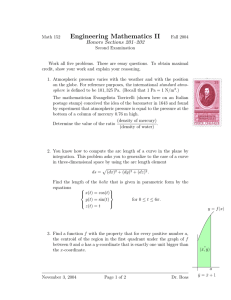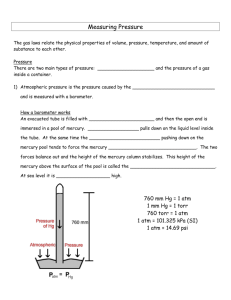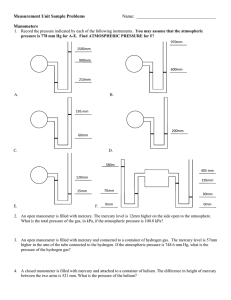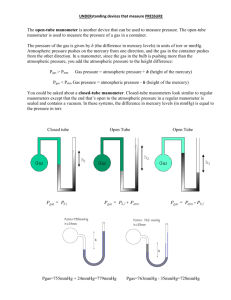ATMOSPHERIC PRESSURE
advertisement
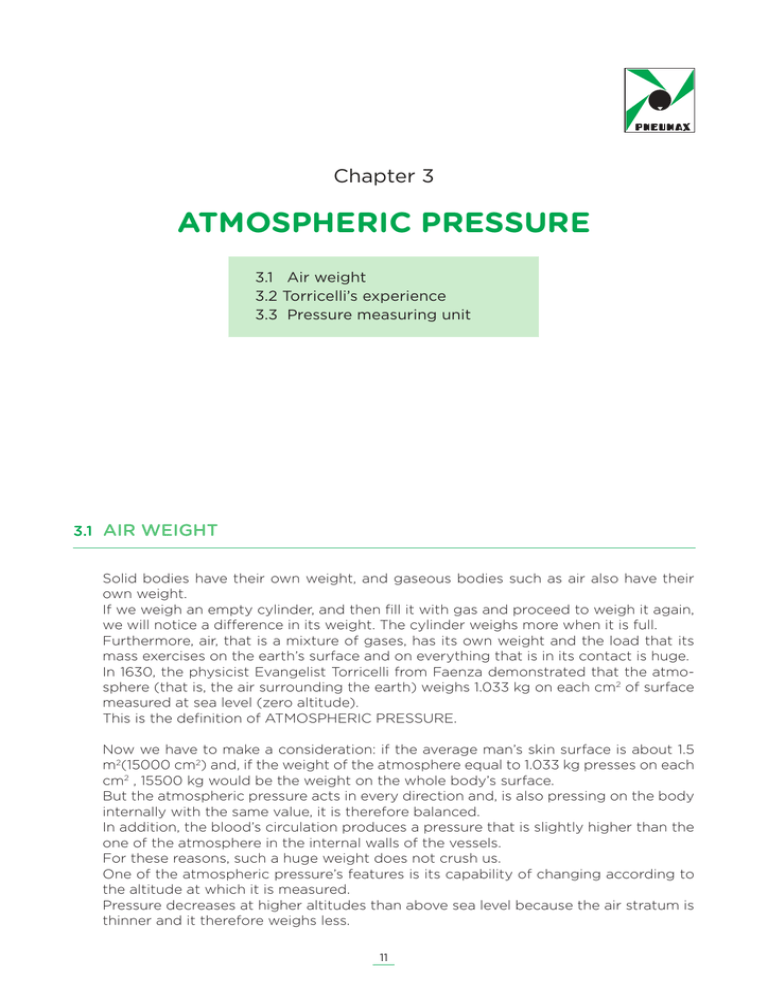
Chapter 3 ATMOSPHERIC PRESSURE 3.1 Air weight 3.2 Torricelli’s experience 3.3 Pressure measuring unit 3.1 AIR WEIGHT Solid bodies have their own weight, and gaseous bodies such as air also have their own weight. If we weigh an empty cylinder, and then fill it with gas and proceed to weigh it again, we will notice a difference in its weight. The cylinder weighs more when it is full. Furthermore, air, that is a mixture of gases, has its own weight and the load that its mass exercises on the earth’s surface and on everything that is in its contact is huge. In 1630, the physicist Evangelist Torricelli from Faenza demonstrated that the atmosphere (that is, the air surrounding the earth) weighs 1.033 kg on each cm2 of surface measured at sea level (zero altitude). This is the definition of ATMOSPHERIC PRESSURE. Now we have to make a consideration: if the average man’s skin surface is about 1.5 m2(15000 cm2) and, if the weight of the atmosphere equal to 1.033 kg presses on each cm2 , 15500 kg would be the weight on the whole body’s surface. But the atmospheric pressure acts in every direction and, is also pressing on the body internally with the same value, it is therefore balanced. In addition, the blood’s circulation produces a pressure that is slightly higher than the one of the atmosphere in the internal walls of the vessels. For these reasons, such a huge weight does not crush us. One of the atmospheric pressure’s features is its capability of changing according to the altitude at which it is measured. Pressure decreases at higher altitudes than above sea level because the air stratum is thinner and it therefore weighs less. 11 Chapter 3 Atmospheric pressure ALTITUDE m PRESSURE Mpa TEMPERATURE °C 0 100 200 500 1000 1400 1800 2000 2400 3000 0,1013 0,1001 0,0989 0,0955 0.0899 0,0856 0,0815 0,0795 0,0756 0,0701 15 14,4 13,7 11,8 8,5 5,9 3,3 2 -0,6 -4,5 3.2 TORRICELLI’S EXPERIENCE Take a transparent tube of about a meter long, closed at one end and open at the other one (figure 3.2), fill it entirely with mercury (Hg) and close the opened end with your finger. Turn it upside down and immerse it into a container with more mercury and we can see that, after having removed our finger from the open end, part of the mercury in the tube passes to the tub. The mercury stops passing to the tub when the tube’s level has reached a certain point. In fact, measuring the difference between the tub’s level of the mercury and the mercury in the tube we can notice that this difference is about 76 cm. The reason why the mercury has not been emptied into the tub is due exclusively to the atmosphere’s air weight. sezione interna Internal section 2 1cm 2 1 cm 760 mm 760mm mm Hg 12 Chapter 3 Atmospheric pressure As previously said, the air exercises a pressure equal to 1.033 kg on each cm2, and therefore, this pressure shall also be exerted on the surface of the mercury contained in the tub. The upper part of the tube, after having being turned upside down, is completely empty of mercury and air. A vacuum has been created, and the atmospheric pressure is totally lacking. In this case, the atmospheric pressure inside the tube, instead of exercising its action from its top and from its bottom, acts only from the bottom toward the top. As the experiment shows, this thrust on the surface unit is equal to the weight of the mercury column according to the tube’s section. Atmospheric thrust = 10,033 kg/cm2 Weight (kg) Unit weight of Gesamtgewicht der = the mercury column Quecksilbersäule Section (cm2) = 1,033 kg/cm2 vacuity 1 cm2 760mm 760 mm Press. Atmosf. Atmospheric pressure Hg In the Torricelli’s tube, the mercury rises due to the atmospheric pressure Proceeding with the same operations, employing water instead of mercury and using an 11 meter long tube, we can see that the water level inside the tube will reach 10.033 m from the surface of the tub. This thrust, according to the tube’s section, is equal to 1.033 kg on 1 cm2 surface. 13 Chapter 3 Atmospheric pressure 3.3 PRESSURE MEASURING DEVICES we refer to pressures we must distinguish: – Atmospheric pressure, a pressure caused by the air’s weight (about 1 kg/cm2); – Gauge or Relative pressure, a pressure higher than the atmospheric pressure, that is measured by instruments called manometers (pressure gauges); – Absolute pressure, the sum of the two previous pressures (gauge pressure + atmospheric pressure); – Depression, a gauge pressure lower than the atmospheric pressure measured by instruments called vacuometers. Its maximum value is referred to barometric vacuum or absolute vacuum. In the international system (SI), the atmospheric pressure at sea level is equal to 100.000 Pa Which are equivalent to 0,1 Mpa In the physics system, this pressure is equal to 101.325 Pa = 0,1013 MPa 14 Chapter 4 PRESSURE MEASURING DEVICES 4.1 Manometers 3.2 Vacuometers or vacuum gauges 4.1 MANOMETERS OR PRESSURE GAUGES Industrially, gauge pressure is measured with instruments called manometers, of which the most used one is the Bourdon. It is based on the elastic deformation of a tubular metal spring with lens section, folded in a semicircular shape and subjected entirely to the pressure exercised by the fluid. An end of the spring is open, and after having fixed it to an externally threaded sleeve in order to fasten the instrument, it remains connected to the fluid of which we want to measure the pressure. The other end is closed, and is free to move under the action of the fluid that presses against it internally, and therefore tends to straighten it out causing a movement of the closed end that is proportional to the applied pressure. By means of the engagement with a sector roller, the movement of this non bonded end is amplified in such a way that an indicator fixed on the roller’s axis shows the pressure value. Bourdon Manometer 15 Chapter 4 Druckmessgeräte 4.2 VACUOMETERS OR VACUUM GAUGES Vacuometers are manometers that measure pressures lower than the atmospheric pressure. In industrial facilities, depression is measured with Bourdon instruments that may be graded in decibars, in cm of mercury or mm of water, according to the purpose for which they are to be designed. 16
